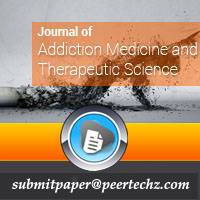Journal of Addiction Medicine and Therapeutic Science
Addiction
Joseph Agassi*
Cite this as
Agassi J (2020) Addiction. J Addict Med Ther Sci 6(1): 001-002. DOI: 10.17352/2455-3484.000028Addiction is usually linked to psychoactive drugs. This is only approximately true, since one can be addicted to common objects such as starch and to abstract items such as some habits, such as attachments to certain objects, often known as fetishism. Moreover, the common use of such drugs, especially alcohol and opium, are seldom addictive. Hence, addiction is a state of mind, an excuse for certain inabilities to cope with normal life stresses. This makes questionable the idea that it is possible to reduce addiction by rendering scarce the drugs usually associated with addiction. The refutation of this idea was the failure of attempts in the United States of America to impose the law forbidding the sale and consumption of alcohol that was on the books there between 1919 and 1932. Yet laws prohibiting the consumption of alcohol exist since time immemorial and are strictly imposed, say, in all strictly Muslim countries. Thus, it is at times but not always possible to impose laws against the use of some addictive substances, yet we know of no society without addiction.
The damage that such laws cause, however, is obviously too great to tolerate. The routes of drug smuggling are the same as those of other smuggling, including illegal weapons and laundered money. Globalization, the movement towards reducing protective taxes as much as possible, needs much deliberation in order to reduce the damages and enhance the benefits that it may cause. This is impeded by drug trafficking.
Most people who are aware of the damages that drug abuse causes support laws prohibiting all use of psychoactive drugs (except for medical and scientific purposes); those who advocate or partake in the use of psychoactive drugs demand the abolition of the laws against that use. Few people express the obviously right view. Among these are most of the workers in centers for treatment of drug addiction, as well as others involved in drug rehabilitation. The right view is this: addiction is a serious problem; the abuse of psychoactive drugs is harmful; yet laws against addiction and against the use of psychoactive drugs only aggravate the troubles. The abolition of these laws may open the road to replacing them with tools that are more effective. These may take more time to achieve results, but then it may be the best way to go about matters.
The most efficient way to go about any ill is usually to find its cause and to see if its eradication is possible. What causes addiction is clearly the inability to take responsibility for one’s life, the absence of moral independence. It is not clear what impedes its growth, but, as we know, certain mistakes in education do that, such as excessive demands from youths. All too often, young people have difficulties integrating in their society; they usually overcome these by themselves or with the aid of peers-with some measure of success. At times, young people need more help but they do not know how to acquire it. Parents or teachers or even by-standers may notice it and help, but not always. This may lead to dependence and thus possibly to addiction. Better sensitivity to youths and to their plights may prevent this.
Modern society suffers from widespread alienation. Not that this did not exist in earlier societies; yet as traditional societies were stable and more harmonized, it was in some sense better capable to rectify their inadequacies (though with much higher prices). Be it as it may, regardless of the past of our education system, today it is not sufficiently integrated. In particular, too many individuals find it too hard to approach others spontaneously with no prior cause for connection. This is greatly improved due to the social media and so these should reduce the rate of addiction. Instead, these media offer new ways for addiction. This need not be a cause for concern, since addiction to the media are less harmful than addiction to the psychoactive drugs, and the addiction to the psychoactive drugs that the media may help promote is hopefully transient. The media help people overcome their alienation; if so, then it will help people avoid addiction or even free themselves of evolving addiction. Indeed, diverse means of the reduction of alienation exist and supporting them should help too. Of course, the pressure to join social groups is very common and educators have to consider overcoming it a major challenge. The more they will succeed in that task the less people will become addicts. And, like many other social ills, it is unreasonable to hope to eradicate it. We should learn to treat its victims with compassion and reduce it as best we can. To that end we should constantly study the extent of its widespread and discuss the relative efficiency of the means that we use in efforts to diminish it to reasonable size
Article Alerts
Subscribe to our articles alerts and stay tuned.
 This work is licensed under a Creative Commons Attribution 4.0 International License.
This work is licensed under a Creative Commons Attribution 4.0 International License.

 Save to Mendeley
Save to Mendeley
